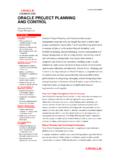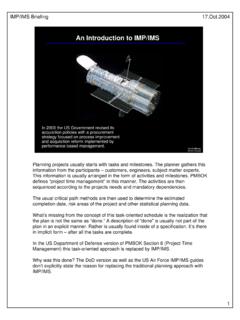Transcription of November 2008 Integrated Project Delivery Frequently Asked ...
1 2008 AIA California CouncilIntegratedProject Delivery Frequently Asked QuestionsNovember 2008 2008 AIA California CouncilIn 2006, The AIA California Council defined Integrated Project Delivery (IPD), as:IPD is a Project Delivery approach that integrates people, systems, business structures and practices into a process that collaboratively harnesses the talents and insights of all participants to optimize Project results, increase value to the owner, reduce waste and maximize efficiency through all phases of design, fabrication and principles can be applied to a variety of contractual arrangements and IPD teams will usually include members well beyond the basic triad of owner, architect, and contractor.
2 At a minimum, though, an Integrated Project includes highly effective collaboration between the owner, the architect, and the general contractor ultimately responsible for construction of the Project , from early design through Project handover. The following graphic illustrates the principles of the Project Delivery processThe definition and diagrams are included in the Integrated Project Delivery Guide (jointly developed by The AIA s Contract Documents Committee and The AIA California Council). Since then, many questions have been Asked that build on the foundation in The Guide. The following Frequently Asked Questions responds to these issues and encourages those in the design and construction industry to embrace IPD as a way to improve Project IPD the same as design-build?
3 Design-build is a Project Delivery model that fits within the umbrella of IPD as defined above. However, design-build is not the same as the IPD models described in AIA documents A195, B195, C195, A295, released in design-build Delivery model, when used according to its best practices, aligns with all of the fundamental principles of IPD. In the ideal IPD and design-build models, the owner, designers and builders work collaboratively from Project inception to mutually establish the performance, budget and schedule within the constraints of the owner s business model. The team works together to collaboratively manage the procurement and management methods vary from Project to Project .
4 Design-build procurement methods include: 1) Qualification Based Selection (selection based on qualifications only)2) Best Value Selection (two-phase selection process with RFQ & RFP, based on criteria documents), and selection using bridging documents" (plans and specifications are developed to a point without the involvement of the contractor who will eventually build the Project )Design-build management may, or may not include the owner to a greater or lesser degree. As design-build moves more toward a bridging procurement, or Project management that does not include the owner, it also begins to move away from the fundamental principles of is IPD different than partnering and other methodologies we have heard before?
5 Partnering is purely aspirational. In a partnered Project , the parties sign a non-binding charter that reflects an intent to interact openly and collaboratively. Partnering does not however, change the basic contract and liability relationships, nor does it create incentives and consequences that flow from achieving or ignoring the collaborative goals. In contrast, IPD is a value driven process. The goals of IPD open communication, collaboration, and decision making in the best interest of the Project as a whole are reinforced through shared risk and reward based on Project , rather than individual performance.
6 There is joint decision making and appropriate liability allocation. IPD aligns the goals we seek to achieve, with the incentives and Project structures needed to accomplish those goals, thus creating a value based, virtual organization aligned to the agreed Project 2008 AIA California CouncilHow is the move to IPD different from the move to CAD-drafting in the 80 s?CAD drafting was simply a change in tools, but processes and Project roles did not change. IPD is not a tool, but a process based on new relationships, where Project participants take on roles beyond their traditional you think IPD is challenging? If so, why?
7 IPD can be challenging because it is new and completely different than the traditional way the industry has been doing business. IPD requires greater collaboration resulting in new technologies, new software, equipment, and training all combined with IPD s expectations. How can design goals that are more subjective be measured since IPD process metrics focus primarily budget and schedule issues? And by whom are they measured by?The goal of IPD is extraordinary results. Design is only one of the dials or performance metrics that must be balanced with the others to meet the owner s business case. Although design is a subjective goal, the Project team needs to define the performance criteria for all metrics and break the criteria into specifics that can be assigned target costs, which in turn will influence design.
8 The Project team is responsible for managing how successfully the Project is meeting the metrics at specific milestones throughout the design and construction you feel as though some misuse IPD, or carelessly and ignorantly apply it?Some owners, architects, contractors, and others in the industry do not fully understand that IPD is a completely different model with its own new and unique attributes. Attempting to use an IPD model without making the mental shift and adopting its new principles can lead to a poor or sometimes disastrous result. Fundamental principles of IPD include: 1) mutual respect and trust 2) mutual risk and reward3) collaborative innovation and decision making4) early involvement of all key participants5) open and enhanced communicationDo you feel perhaps there should be a hard-to-get credential to use this system?
9 Maybe some form of certification for IPD use?No credential or certification should be required. IPD is not a prescribed sequence of activities and roles for all Project types. The success of an IPD Project is based on individual team member s ability to make decisions collaboratively, apply the tools and systems and align the business culture and business models of the individual firms involved in the Project . Thus the combined experience of the individuals within a firm is more important than certification at this time in the development of IPD. Finally, the owner is the third party in the collaborative effort. However, our academic education and intern programs should include extensive exposure to working in collaborative teams inclusive of designers, engineers, builders and fabricators.
10 Some professionals insist IPD is expensive to implement (especially in training costs associated with BIM and collaboration). What is the value proposition for IPD? Based on this assumption, do you feel it will be difficult to bring consultants on board?Design professionals typically collaborate with other design professionals to deliver their services. IPD extends this collaboration to the entire owner/building team. IPD does include BIM as an essential, for optimal benefit; but BIM is not required to participate in an IPD process. The value proposition for the collaboration and/or BIM is to invest in the effort early, or react to the questions/problems later.








